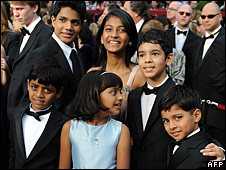 Long after the Oscar parties fade into tomorrow’s hangover, the reality of the suffering portrayed in “Slumdog Millionaire” will persist. If the film moved you and you want to know, “Why isn’t anyone DOING anything about this horrible situation?” … well, maybe someone is. And maybe that someone could be you. Read on for scenes from the movie, the corresponding reality, and what’s being done about it.
Long after the Oscar parties fade into tomorrow’s hangover, the reality of the suffering portrayed in “Slumdog Millionaire” will persist. If the film moved you and you want to know, “Why isn’t anyone DOING anything about this horrible situation?” … well, maybe someone is. And maybe that someone could be you. Read on for scenes from the movie, the corresponding reality, and what’s being done about it.
movie: Jamal rescues a pre-teen Latika from a brothel where she is forced to dance for older men.
reality: Hundreds of thousands of girls are trafficked into prostitution in India, with Mumbai’s red-light district being one of the largest and most brutal in the world. I give to the Global Fund for Women, an amazing U.S.-based foundation that funds grassroots groups for girls and women around the world, with a special focus on trafficking issues. The groups they fund work to free girls from prostitution; give them options for physical, emotional, and economic recovery; and prevent girls from being sold or kidnapped into the trade in the first place. Learn more about trafficking, donate now or shop your values.
movie: Poor children hustle to make ends meet, work for unscrupulous characters, and don’t go to school.
reality: Elimination of child labor is tough organizing work that has to be done child by child, neighborhood by neighborhood, community by community. Moving children from hustling, begging, and informal labour into schools also requires empowering their caretakers through programs such as micro-loans supporting small-scale entrepreneurialism by women. Hand in Hand is an India-based non-profit that works to end child labor in rural Tamil Nadu and “aims at building self-reliance of disadvantaged groups by alleviating poverty through sustained income generating programmes.” Read a BBC article about the work of Hand in Hand or visit the organization’s website.
movie: Poop scene, women washing clothes in public pool.
reality: Yep, sewage and water are not sexy issues but they are huge. Informal settlements such as Dharavi, though they are often referred to as slums, are larger than most cities in the world — yet basic services are lacking. Lack of access to clean water and sewage leads to poor health outcomes for children and adults. The Society for Human and Environmental Development (SHED) works on these important issues in Dharavi; the writing on the website is a bit random and hard to wade through, but here’s a much better article on their work.
movie: People climb on garbage heaps, picking through refuse and living there.
reality: Yes, this is how some of the poorest Indians eke out a living. ACORN International’s Dharavi Project is working to organize rag pickers and waste collectors (those children climbing the garbage piles in the movie) in Dharavi. The international wing of ACORN is affiliated with the U.S. ACORN “community organizers” who were subject of a manufactured controversy during the Obama campaign. Both ACORNs do amazing, from-the-ground-up community organizing that aims to empower the disempowered to advocate for their own rights and make needed changes in their own community, rather than take a top-down “charity” approach.
movie: Children of the Dharavi slum go through all kinds of shit, no adults help them.
reality: yeah, children of Dharavi go through all kinds of shit. The adults and organizations around them are severely under-funded to meet the need. Maybe that’s where we in the privileged West can make a contribution, if we educate ourselves a little bit. So in addition to the organizations above, here are few more groups and resources:
SNEHA, the Society of Nutrition, Education & Health Action, was formed in 1999 “by a group of concerned doctors and social workers to address the special needs of women and children in urban slums.” Here’s an article about their Kishori Project in Dharavi: “In Asia’s largest slum, the Kishori project is introducing young girls to reproductive healthcare, pregnancy care, HIV/AIDS and more. As added inducement, low cost trainings in computers and tailoring are drawing them to the centre for a chance to earn and save money.”
“Slumdog Millionaire” actor and Bollywood star Anil Kapoor has donated his entire fee from the movie to a children’s charity called Plan India. Article here, Plan India website here.
Dharavi.org is a multimedia wiki website designed to gather information, images, and ideas on Dharavi in Mumbai. Specifically, it offers a space to discuss the Dharavi Redevelopment Project and its alternatives.
*DO YOU KNOW of an organization, site, or resource that should be on this list? Please post a comment on the blog, or email me and I’ll update the list.
**PLEASE NOTE that this list is not vetted thoroughly; you should always check out organizations to your own satisfaction before transferring funds, especially internationally.